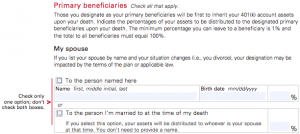One of the great advantages of being self-employed is the ability to open and manage your own small business retirement account. Employed people have to either take or leave their employer’s 401(k) or 403(b) plan offerings, regardless of the quality or cost of the funds it offers, while the self-employed get to choose their own plan provider and pick exactly the assets they want to invest in. Naturally, many choose Vanguard, and since I recently opened a solo 401(k) with them, I thought it would be useful to share my experience.
Opening an account (1): selecting funds
To open a solo 401(k) with Vanguard you have to download and print the “Individual 401(k) kit for employers” from their small business website. The kit is pretty straightforward, although there are a few sections I want to highlight.
In section 3 of the New Account Form you have the option of opening either a traditional, pre-tax account, a Roth, post-tax account, or both.
If you open a pre-tax account, you have to select at least one fund to receive your contributions:

Likewise if you open a Roth account, you have to select at least one fund:

There’s a $20 annual fee charged per fund held in each account, so if you open both accounts you’ll have to pay $20 per fund each year, even if you hold the same fund in both accounts. The $20 fee is waived if you have $50,000 in assets across all your Vanguard accounts (so-called “Voyager services”).
Note that Solo 401(k)’s do not have access to Vanguard’s lower-cost Admiral shares. That matters for two reasons: first, you’ll pay slightly more for funds that you currently own as Admiral shares. That’s bad. But it also matters because when people compare the fees on Vanguard’s all-in-one funds to a “do it yourself” portfolio of Vanguard funds, they are usually comparing the all-in-one fund costs to the cost of Admiral shares. But if you don’t have access to Admiral shares, that’s not the right comparison.
For example, Vanguard 500 Admiral shares have a hyper-low expense ratio of 0.05% — a third the cost of a Target Retirement or LifeStrategy fund. But Vanguard 500 Investor shares, the ones you have access to in a Solo 401(k), have an expense ratio of 0.16%! Suddenly the comparison doesn’t seem so compelling, particularly if it comes with the added $20 per-fund fee and the additional hassle of periodic rebalancing. That’s one reason I chose the LifeStrategy Growth fund for my 401(k), as you’ll see below.
Opening an account (2): designating beneficiaries
Vanguard has what appears to be an extremely straightforward system for designating beneficiaries. First, you select your primary beneficiary:

Then, you select your secondary beneficiary:

This is not, in fact, an extremely straightforward system. As my primary beneficiary, I selected “To the person I’m married to at the time of my death,” and as my secondary beneficiary I selected my partner. About a week later I got a call from Vanguard to clear up their confusion. It turns out that in spite of all logic and reason, you’re only supposed to select “To the person I’m married to at the time of my death” if you’re already married, which seems to me to defeat the purpose of such a checkbox, but what do I know?
Making contributions
Once Vanguard has accepted your plan documents, you’ll receive a barrage of mail from them, including information on configuring your online account administrator access. Unlike the fairly powerful personal investor interface, the small business interface is extremely primitive:

When you select “Make a contribution online” you’re first asked which tax year the contribution is for, and then taken to this screen:

The “Individual 401(k)” contribution fields are for pre-tax contributions, which can be made as employer or employee contributions (more on that in a moment). The “Individual Roth 401(k)” contribution fields are for post-tax contributions, which can only be made as employee, not employer, contributions.
Contribution limits
Solo 401(k) contributions limits aren’t hard, they’re just complicated. I think the best way to think about them is in three parts:
- 100% of net self-employment income, minus half the self-employment tax, up to $18,000. If your net self-employment income from Schedule C is less than $19,491, then you can contribute 92.35% of your net self-employment income in the left-hand “employee” contribution columns. You can split that amount between the pre-tax Individual and after-tax Roth fields however your own tax needs dictate.
- 25% of your remaining net self-employment income, minus half the self-employment tax. If your net self-employment income is $30,000, then after deducting half the self-employment tax ($2,295), you’re left with $27,705. You can contribute 100% of the first $18,000 in the left-hand “employee” column and 25% of the remaining $9,705 ($2,426) in the pre-tax right-hand “employer” column.
- $54,000. The most you can contribute in total to a solo 401(k) plan per calendar year is $54,000 in 2017. To make $54,000 in solo 401(k) contributions you’d need to make $175,419 in net self-employment income. Deducting half the self-employment tax would leave you with $162,000, and after contributing the maximum $18,000 in employee contributions you’d be left with $144,000, 25% of which is the $36,000 in employer contributions you need to reach the maximum.
Note that you do not need to actually make contributions in this order!
This is simply the order that will maximize your contributions for a given level of self-employment income. You can reach the $54,000 contribution cap exclusively from employer contributions. However, the required net self-employment income is much higher: $54,000 is 25% of $216,000, which is almost $234,000 in net self-employment income after the self-employment tax is added back in.
And of course if you want to take advantage of Individual Roth 401(k) contributions those can only be made as employee, not employer contributions.
Adding and exchanging funds
An important benefit of Vanguard retirement accounts is that it’s possible to contribute to funds without meeting the minimum initial investment requirement. In other words, you don’t need to contribute $3,000 in order to purchase shares of a fund that otherwise has a $3,000 minimum investment.
However, this benefit is only extended to contributions processed through the small business investing portal. When you log into your personal investor account, you’ll see your 401(k) account(s) there but won’t be able to transact the funds in those accounts until you meet the minimum investment requirements.
If you want to add a new fund to your 401(k) but don’t want to exchange shares in an existing fund, Vanguard can do this over the phone if you call 1-800-205-6189. The reasons for doing so might be to trigger the minimum investment waiver for future contributions to the account, or simply to diversify your existing funds.
Conclusion
Solo 401(k) plans are a way to defer taxes on a substantial amount of self-employment income and, in Roth accounts, potentially avoid taxes entirely by making Roth contributions in years when you are able to pay little or no federal income tax.
Vanguard’s Solo 401(k) kit makes it just about as easy as possible to get started, given the legal requirements involved. And even if you make a mistake when designating your beneficiaries or selecting funds, their phone personnel have been extremely capable every time I’ve had to speak with them (including researching this post).
And of course, best of all a Vanguard Solo 401(k) gives you access to Vanguard’s suite of low-cost mutual funds!
Cool summary, will definitely reference this if I ever get up to a reasonable amout of SE income. One quick question:
Is the $20 fee per fund a yearly thing? monthly? one-time? something else?
Noah,
Yes, $20 per fund yearly, I’ll update the post to clarify!
—Indy
Why choose to do a 401k instead of an IRA?
Tyler,
401k and IRA are two great tastes that taste great together. If your earnings are less than $5,500 then you can stick with an IRA, but the advantage of 401k plans is the much higher annual contribution limit.
—Indy
I may be mistaken, but I think that last calculation of $162 to $144 isn’t correct. I think you can max it out with a salary of $144, (which does require ER side SE tax to be added) which is lower.
What if I want to put 100 shares of Apple in my acct? Will vanguard buy it for me? Same fee? If I already have the stock can I move it into acct? I am used to.401k that charged buy and sell fee and maintanence fee. $25 /acct but that was awhile ago. Could have anything in acct and as long as no buy or sell, that was annual fee.
Mom,
No, Vanguard 401k accounts can only hold Vanguard mutual funds. If you want to hold individual stocks or non-Vanguard mutual funds or ETF’s you have to find another provider.
—Indy
This may have changed in the 2 years since I last compared Vanguard’s solo 401k options, but I actually found Fidelity to offer a better product. Fidelity’s has no fees (other than standard brokerage commissions) and you have full access to Fidelity’s suite of index funds. Another issue for me was that I wanted to roll a SEP IRA into my newly established solo 401k, and at the time (2 years ago), Vanguard’s plan did not accept rollovers into solo 401k’s, whereas Fidelity’s plan did. The reason this was important was because I wanted to take advantage of contributing to a non-deductible IRA each year and converting it to a Roth IRA, and I needed to minimize the assets I had in pre-tax IRA’s (which would become partially taxable when I converted the IRA to a Roth).
Smitty,
You’re correct, Vanguard doesn’t allow IRA’s to be rolled into their prepackaged solo 401k’s.
—Indy
I think this, along with the fact that Fidelity doesn’t charged fees per mutual fund, tips the balance in Fidelity’s favor. I’m a huge fan of Vanguard’s but this was one of the few times I felt they didn’t live up to the competition.
Smitty,
Vanguard’s offering is definitely “plain vanilla,” it doesn’t offer 401k loans either. On the other hand, I think the missing features are used by very few people (i.e. people affected by IRA contribution caps), although they get a disproportionate amount of attention in the FIRE and finance gaming spaces.
—Indy
I’m thinking of opening one of Vanguard’s solo 401k’s but was worried I wouldn’t have the three grand minimum for a fund. It’s good to know that requirement is waived somewhat.
Also, does Vanguard help keep you from accidentally overcontributing like they do with their IRAs?